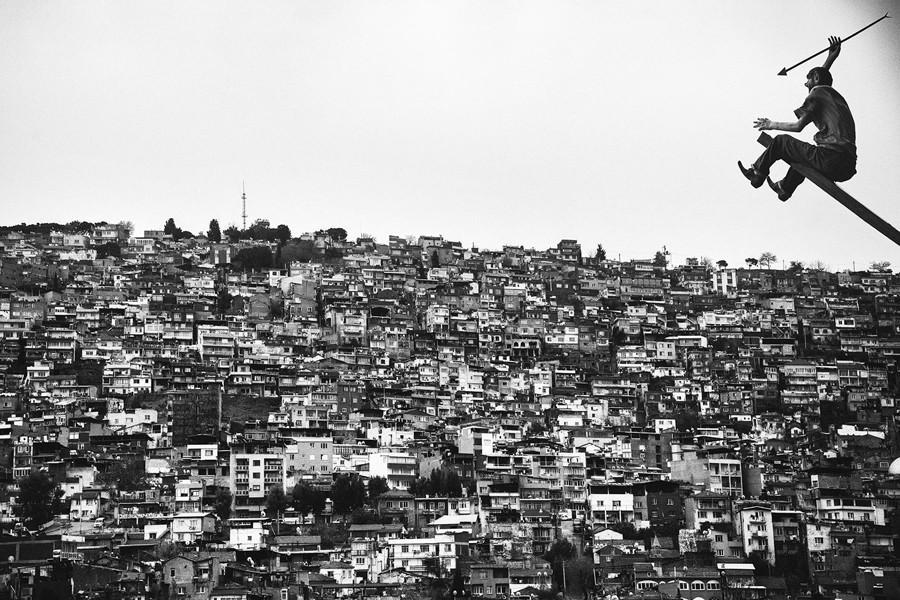
Istanbul’s Pera Museum presents “A Road Story: 180 Years of Photography,” a unique successor of its various photography themed exhibitions ranging from photojournalism to photo art.
The exhibition marks the 180th year of the very first known group photography trip that took place in 1839 and brings together interpretations and perspectives of photographers who explore the same route with today’s techniques.
“While planning this visual trip, we had never thought that taking photographs in certain locations could be more difficult today than 180 years ago, given today’s superior means of transportation and communication.” and adds “This great project took two and a half years to complete and turned into a true road story from the first to the last traveler,” curator Engin Özendes says.
The “road story” features photographers Coşkun Aral, Laleper Aytek, Ali Borovalı, Murat Germen, Sinan Koçaslan, Yusuf Sevinçli, Alp Sime, Lale Tara, Serkan Taycan and Cem Turgay.
Özendes interprets the productions of the artists saying, “Taycan took photographs of Marseille, Livorno, Malta and Rome, employing a critical and contemporary approach in his photography. Laleper Aytek went to the island of Syros to take urban photographs that echoed an internal journey, in search of unrelated details and moments of people, places, and situations. Borovalı photographed Paros, Naxos and Santorini with his simple yet realistic artistic style, as exhibited in his journalistic photography series on nature and local culture.
“Germen used photography as a means for expression and study; instead of conveying directly what he saw, he attempted to create an image by combining it with his artistic interpretation in Alexandria, Cairo, Luxor and Suez as always.
Knowing the Middle East and its constant turmoil, Aral took photojournalistic photographs of Mount Sinai, Gaza, Bethlehem, Jerusalem, Nablus, Saida, Deir Al Qamar, Damascus and Tripoli. Koçaslan used a modern approach to photograph life in Baalbek and Beirut. Sevinçli took photographs in Larnaca and Rhodes, depicting quotidian experiences, interactions, and the environment.
“Tara went to Kos and took photographs on the island like a visual storyteller and an experimental player, creating a different atmosphere for her story by preparing for her shoots like one would create a movie set, complete with costumes, location scouting, and lighting.
“Turgay employed his experimental style to photograph İzmir, based on pastel-colored lights, hazy shadows, and critical details. Sime photographed daily life in Çanakkale and Istanbul, using a modern language and an aesthetical and powerful expression in his realistic black and whites.”
Those interested in photography all recognize 1839 as a year of special importance. The invention of photography was announced on Aug. 19, 1839, and Oct. 21, 1839, marks the beginning of the first journey of photography.
French painter Émile Jean Horace Vernet, painter Charles Marie Bouton who is among the inventors of Diorama technique, and daguerreotypist Frédéric Auguste Antoine Goupil-Fesquet depart from the Port of Marseille in October 1839 to take photographs and return to Marseille six months later, in April 1840 passing from Livorno, Malta, Syros, Paros, Naxos, Santorini, Alexandria, Cairo, Luxor, Suez, Mount Sinai, Gaza, Bethlehem, Jerusalem, Nablus, Sayda, Deir Al Qamar, Damascus, Tripoli, Baalbek, Beirut, Larnaca, Rhodes, Kos, Izmir, Dardanelles, Istanbul and Rome.
Goupil-Fesquet conveyed his impressions about this journey in his book, Voyage d’Horace Vernet en Orient, which would be published in 1843.
“A Road Story: 180 Years of Photography,” which opened on Dec. 5, will be on view through March 1, 2020.